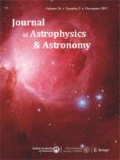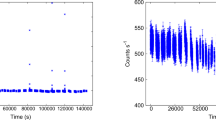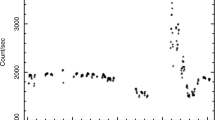Abstract
We performed the timing and spectral studies of a Z source GX 17+2 observed from Astrosat LAXPC instrument. Cross-Correlation Function (CCF) was performed using soft (3–5 keV) and hard (16–40 keV) X-ray bands across the hardness intensity diagram and found correlated/anti-correlated hard and soft lags which seems to be a common feature in these sources. We performed spectral analysis for few of these observations and found no consistent variation in the spectral parameters during the lags, however 10–40% change was noticed in diskbb and power-law components in few of observations. For the first time, we report the detection of HBOs around \(\sim \)25 Hz and \(\sim \)33 Hz along with their harmonics using AstroSat LAXPC data. On comparison with spectral results of HB and other branches, we found that inner disk front is close to the last stable orbit and as such no systematic variations are observed. We suggest that the detected lags are readjustment time scales of corona close to the NS and constrained its height to be around few tens to hundreds of km. The detected lags and no significant variation of inner disk front across the HID strongly indicate that structural variation in corona is the most possible cause of Z track in HID.









Similar content being viewed by others
References
Agrawal V. K., Nandi A., Ramadevi M. C., 2020, Ap&SS, 365, 41
Alpar M. A., Shaham J. 1985, Nature, 316, 239
Antia H. M., Yadav J. S., Agrawal P. C. et al. 2017, ApJS, 231, 10
Cackett E. M. et al. 2008, ApJ, 674, 415
Cackett E. M. et al. 2009, ApJ, 690, 1847
Cackett E. M., Miller J. M., Ballantyne D. R. et al. 2010, ApJ, 720, 205
Davis S. W., Blaes O. M., Hubeny I., Turner N. J. 2005, ApJ, 621, 372
Fortner B., Lamb F. K., Miller G. S. 1989, Nature, 342, 775
Galloway D. K., Muno M. P., Hartman J. M., Psaltis D., Chakrabarty D. 2008, ApJS, 179, 360
Hasinger G., van der Klis M. 1989, A&A, 225, 79
Hasinger G., van der Klis M., Ebisawa K., Dotani T., Mitsuda K. 1990, A&A, 235, 131
Homan J., van der Klis M., Jonker P. G. et al. 2002, ApJ, 568, 878
Kara E. et al. 2019, Nature, 565, 198
Kuulkers E., van der Klis M., Oosterbroek T., Asai K., Dotani T., van Paradijs J., Lewin W. H. G. 1994, A&A, 289, 759
Kuulkers E., van der Klis M., Oosterbroek T., van Paradijs J., Lewin W. H. G. 1997, MNRAS, 287, 495
Kubota A., Tanaka Y., Makishima K., Ueda Y., Dotani T., Inoue H., Yamaoka K. 1998, PASJ, 50, 667
Lamb F. K. 1989, in Hunt J., Battrick B., eds, Proceedings of the 23rd ESLAB Symposium on Two Topics in X-Ray Astronomy, Vol. 1: X Ray Binaries, Vol. 2: AGN and the X Ray Background, ESA, Noordwijk, p. 215
Lei Y. J., Qu J. L., Song L. M. et al. 2008, ApJ, 677, 461
Lin D., Remillard R. A., Homan J. 2007, ApJ, 667, 1073
Lin D., Remillard R. A., Homan J., Barret D. 2012, ApJ, 756, 34
Ludlam R. M. et al. 2017, ApJ, 836, 140
Malu S., Sriram K., Agrawal V. K. 2020, MNRAS, vol. 499, Issue 2 (2009.11002v2)
Manmoto T., Mineshige S., Kusunose M. 1997, ApJ, 489, 791
McKinney J. C., Tchekhovskoy A., Blandford R. D. 2012, MNRAS, 423, 3083
Mitsuda K., Inoue H., Koyama K. et al. 1984, PASJ, 36, 741
Miyamoto S., Kimura K., Kitamoto S., Dotani T., Ebisawa K. 1991, ApJ, 383, 784
Osherovich, V., Titarchuk, L. 1999a, ApJL, 522, 113
Osherovich, V., Titarchuk, L. 1999b, ApJL, 523, 73
Pen U.-L., Matzner C. D., Wong S. 2003, ApJ, 596, L207
Penninx W., Lewin W. H. G., Zijlstra A. A. et al. 1988, Nature, 336, 146
Priedhorsky W., Hasinger G., Lewin W. H. G., Middleditch J., Parmar A., Stella L., White N. 1986, ApJ, 306, L9
Psaltis et al. 1999, ApJ, 520, 763
Shakura N. I., Sunyaev R. A. 1973, A&A, 24, 337
Shimura T., Takahara F. 1995, ApJ, 445, 780
Sriram K., Agrawal V. K., Pendharkar J. K., Rao A. R. 2007, ApJ, 661, 1055
Sriram K., Agrawal V. K., Rao A. R. 2009, RAA, 9, 901
Sriram K., Rao A. R., Choi C. S. 2012, A&A, 541, A6
Sriram K., Malu S., Choi C. S. 2019, ApJS, 244, 5S
Stella L., Vietri M. 1999, Phys. Rev. Lett., 82, 17
Stella L., Vietri M., Morsink S.M. 1999, ApJL, 524, 63
Titarchuk L., Bradshaw C. F., Geldzahler B. J., Fomalont E. B. 2001, ApJ, 555, 45
Titarchuk L. G., Osherovich V. A. 1999, ApJL, 518, 95
van der Klis M. 2006, in Lewin W., van der Klis M., eds, Compact Stellar X-ray Sources, Cambridge Univ. Press, Cambridge, p. 39
van der Klis M. 1988, in Ogelman H., van den Heuvel E. P. J., eds, NATO Advanced Science Institutes (ASI) Series C, Vol. 262, NATO Advanced Science Institutes (ASI) Series C, p. 27
Vaughan B. A., van der Klis M., Lewin W. H. G., van Paradijs J., Mitsuda K., Dotnai T. 1999, A&A, 343, 197
Vrtilek S. D., Raymond J. C., Garcia M. R. et al. 1990, A&A, 235, 162
White N. E., Peacock A., Hasinger G., Mason K. O., Manzo G., Taylor B. G., Branduardi-Raymont G. 1986, MNRAS, 218, 129
Wijnands R. et al. 1997, ApJ, 490, L157
Wu, X. B. 2001, ApJ, 552, 227
Yadav J. S., Agrawal P. C., Antia H. M. 2016, Proc. SPIE, 9905, 99051D
Zdziarski A. A., Johnson W. N., Magdziarz P. 1996, MNRAS, 283, 193
Acknowledgements
We thank the referee for the comments that has improved the quality of the paper. K.S. and C.P. acknowledge the financial support of ISRO under AstroSat archival Data utilization program. This publication uses data from the AstroSat mission of the Indian Space Research Organisation (ISRO), archived at the Indian Space Science Data Centre (ISSDC). K.S. also acknowledges the financial support from SERB CRG program. M.S. acknowledges the financial support from DST-INSPIRE fellowship. V.K.A. thanks GH SAG; DD PDMSA, and Director URSC for encouragement and continuous support to carry out this research. Authors sincerely acknowledge the contribution of the LAXPC team toward the development of the LAXPC instrument on-board the AstroSat. This work uses data from the LAXPC instruments developed at TIFR, Mumbai, and the LAXPC POC at TIFR is thanked for verifying and releasing the data via the ISSDC data archive. Authors thank the AstroSat Science Support Cell hosted by IUCAA and TIFR for providing the LAXPC software that was used for LAXPC data analysis.
Author information
Authors and Affiliations
Corresponding author
Additional information
This article is part of the Special Issue on “AstroSat: Five Years in Orbit”.
Rights and permissions
About this article
Cite this article
Sriram, K., Chiranjeevi, P., Malu, S. et al. Understanding the inner structure of accretion disk in GX 17+2: AstroSat’s outlook. J Astrophys Astron 42, 96 (2021). https://doi.org/10.1007/s12036-021-09760-0
Received:
Accepted:
Published:
DOI: https://doi.org/10.1007/s12036-021-09760-0




